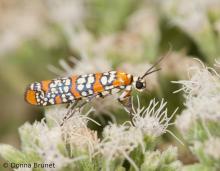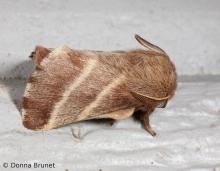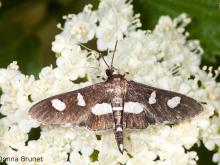Butterflies and Moths
Media

Species Types
Scientific Name
Atteva aurea
Description
Ailanthus webworm moths visit flowers in the daytime but also come to lights at night. Larvae live communally in silken webs in tree-of-heaven, an invasive tree from Asia.
Media

Species Types
Scientific Name
Malacosoma americana
Description
The silken tents of eastern tent caterpillars are conspicuous each spring in the forks of apple, cherry, and plum trees. The adult moths are brown with two pale stripes on the forewings.
Media

Species Types
Scientific Name
Estigmene acrea
Description
The salt marsh moth, a type of tiger moth, is strikingly white with small black spots. Males have yellow-orange hindwings. The caterpillars are fast-moving woolly bears ranging from yellowish to brown to blackish.
Media

Species Types
Scientific Name
Hyphantria cunea
Description
Fall webworm moths may be either completely white or have varying amounts of dark spots. The larvae are hairy caterpillars that live communally in late summer and fall in tentlike webs on the branch tips of trees.
Media

Species Types
Scientific Name
Alypia octomaculata
Description
The eight-spotted forester is a spiffy, butterfly-like moth. It is a fast, darting flyer and dazzles the eye when it flitters around flowers.
Media

Species Types
Scientific Name
Schizura ipomoeae
Description
The morning-glory prominent is common but easily overlooked in Missouri’s woods. The caterpillars mimic curled, dead edges on the leaves they feed on, and the adults blend in with tree bark.
Media

Species Types
Scientific Name
Desmia spp.
Description
There are nine species of leaffolder moths in North America, and even specialists must labor to separate them.
Media

Species Types
Scientific Name
About 75 species in North America north of Mexico
Description
Missouri has 16 species of saturniid, or giant silkworm moths. Many of them are spectacular, including the cecropia, luna, buck, io, imperial, polyphemus, rosy maple, spiny oakworm, and royal moths.
Media

Species Types
Scientific Name
Hyalophora cecropia
Description
The cecropia moth looks a lot like butterfly ― but note its feathery antennae and stout, hairy body. This is the largest moth native to North America.
Media

Species Types
Scientific Name
About 250 species recorded for Missouri
Description
Geometrid moths usually hold their wide wings spread flat against the surface they’re resting on. The caterpillars in this large family are twig mimics; called inchworms or loopers, they “walk” by humping their backs.
See Also


Media

Species Types
Scientific Name
About 1,500 species in North America north of Mexico
Description
Adult caddisflies are mothlike. Their larvae are aquatic and build portable, protective cases out of local materials, including grains of sand, bits of leaves and twigs, and other debris.
Media

Species Types
Scientific Name
Corydalus cornutus
Description
Adult eastern dobsonflies are huge and mothlike, with large wings and a weak, fluttery flight. The fiercely predaceous aquatic larvae, called hellgrammites, are well-known to anglers, who often use them as bait.
About Butterflies and Moths in Missouri
Butterflies, skippers, and moths belong to an insect order called the Lepidoptera — the "scale-winged" insects. These living jewels have tiny, overlapping scales that cover their wings like shingles. The scales, whether muted or colorful, seem dusty if they rub off on your fingers. Many butterflies and moths are associated with particular types of food plants, which their caterpillars must eat in order to survive.





















